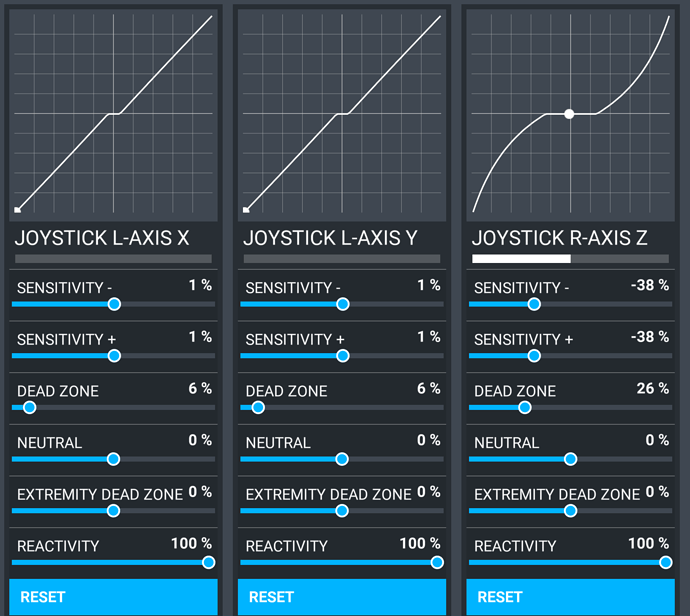Hi guys, the Fenix A320 is getting hard for me to control it in the ground, specially when giving full left or right rudder or when landing. i am use to the behavior that when you give full left (like turning at the end of a runway) and then back to center the aircraft immediately stops turning and center itself accordingly. But on the Fenix it takes some seconds for the aircraft to centered. So becomes very uncontrollable since you know it will keep turning for some seconds even tough your rudders has been in the center seconds ago.
Is this a true behavior, is it a bug or a setting issue that i might ignoring?
these are my current settings for the rudder. I have to say they work fine with all other aircraft!
Thanks for any tipp!
1 Like
Youre settings are not the main issue. Although, I’m not surprised that it’s hard to control with a deadzone of 26.
Full left or right on the rudder? That (in real life) crashes a plane, like in Brooklyn, 2001. Rudders (and elevators and ailerons) need subtle movement. You expect a +60.000 kg aircraft turn like a Mini Cooper.
The behaviour on the ground is nosewheel steering, and is totally different from rudder steering. In the sim it’s combined in 1 controller for ease of use.
1 Like
Thanks! Question: when you do full rudder left or right on the ground and then back to neutral, does the aircraft stops turning immediately or keeps turning for a second and then corrects to center?
This issue of making the Felix landings in high cross winds conditions very hard to Land since the rudder inputs, once touchdown, have a delay in the reaction…
You would have trouble landing with that large of a dead zone in those conditions.
A large dead zone could also cause a small lag in response.
Unless you need a deadzone, set it to 0.
After that, experiment with the sensitivity to get the best response.
I have seen some addons that require positive values.
1 Like
Hi Felipe,
Interesting question !
I have never flown IR such a big plane. So my answer is from a theoretical point of view.
Both answers may be correct.
A “precise” modeling would have to take into account the friction forces of the wheels. Here the
programmers would need eperimental data, they probably don’t have.
I assume slip is set to zero under normal conditions.
That would result in an instantaneous change in direction.
When there’s slip and the plane can react only to the rudder input, then inertia dominates,
what would mean you get a delay: first you have to stop the rotation into the unintended direction,
only after that time the plane begins to rotate into your intended direction. In real, sometimes that may feel like an eternity.
Another example for the action of inertia, which you can verify in the sim too ( best with heavy planes during the flare) is the behavior of the plane on elevator input:
When you pull up, the plane begins to rotate slowly, but the downforce on the elevator is there almost instantaneously, so you’ll loose, for example, 10 meters in altitude, until the comparably slow rotation compensates for the elevator downforce with a higher angle of attack.
(Only for models where the elevator is behind the center of gravity)
bye walter
corrected 22.12.2022
1 Like
Honestly, i never make that kind of extreme movements on rudder or nosewheel. If (on the ground) you have to make these movements to make a turn, you’re going too fast towards and through the turn.
On final approach, with heavy crosswinds (after disconnect ap, click twice on ap-off button) you’ll need to ‘surf’ towards the wind, using both ailerons and rudder. Training provides the skill. And obviously your plane has to be configured properly, otherwise you’ll get an incorrect Vapp speed! Maybe it’s better to train first with light wind, and gradually increase wind speed and ~angle.
After landing the plane is supposed to roll out with hardly any need to correct. When you start manual braking and disconnect the spoilers the steering is yours again. Again, for all this the plane has to be configured properly. Watching YT-videos and tutorials helps a lot! E.g.: 320 Sim Pilot, EasyJet Sim Pilot, Jonathan Beckett, V1-simulations and more.
Regarding your settings: Less deadzone and more curve around these deadzones helps a lot. Again, look on YT or Google for sensitivity settings. I took mine from EasyJetsimpilot.

Good luck! And, more importantly, have fun! After many years of simming, i too still have botched landings.  and learned not to be hard on myself.
and learned not to be hard on myself.
1 Like
Very true (setting it to 0)! But if you don’t use separate rudder-pedals, but the stick-twist instead, landing can become very confusing with no deadzones on all 3 axis. Before i bought the pedals, i used deadzones of 2-4%.
1 Like

